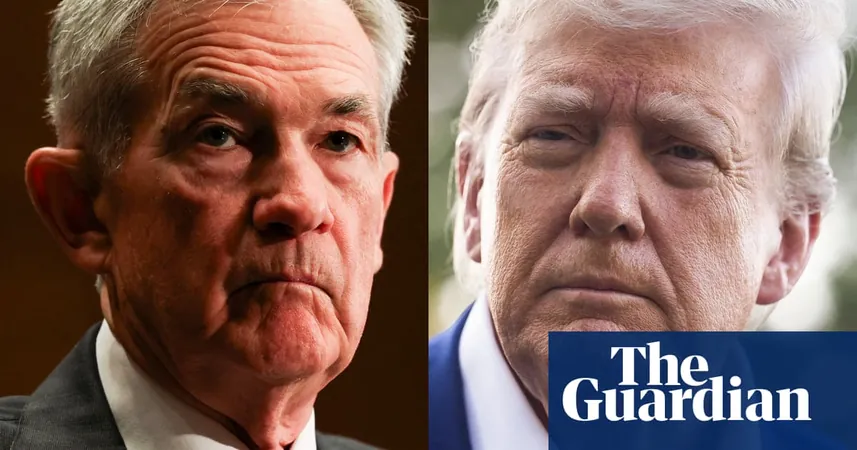
Trump's Bold Push Against the Fed: Can He Really Make an Impact?
2025-07-07
Author: Kai
In a surprising twist that has whipped up speculation and grabbed headlines, former President Donald Trump has turned his attention sharply on the Federal Reserve, recently communicating his frustrations through a handwritten note to its chair, Jerome Powell. In this unconventional move, Trump berated Powell, claiming, "You have cost the USA a fortune and continue to do so. You should lower the rate – by a lot!" His nickname for Powell, "Too Late," adds a dramatic flair to this high-stakes economic saga.
Trump's focus on the Fed isn't unprecedented given the economic anxiety sweeping the nation amid escalating trade tensions. The stock market took a nosedive earlier in the year when Trump announced hefty tariffs, only to rebound once he began to roll back those measures. With fears rising about the economy's health, it's no wonder Trump's ire is aimed at the institution that influences interest rates and, thereby, economic momentum.
Interest rate manipulation is a powerful tool in the Fed's arsenal. Higher rates typically translate to costlier borrowing for everything from home mortgages to business loans, which can put the brakes on investment and economic growth. A reduction in these rates could ignite market activity but might come with long-term repercussions.
But just how much control does Trump really wield over the Federal Reserve?
Economists highlight that Trump's confrontational approach, particularly toward Powell, represents a seismic shift from the traditional, more muted relationship between U.S. presidents and the Fed. However, they caution that the Fed's structure inherently limits Trump's power, particularly in the immediate term.
Historically, the Fed has operated as a nonpartisan entity, independent from political influence—a crucial factor in stabilizing nations' economies. As economist Jason Furman puts it, "A central bank’s independence is pretty much the only thing macroeconomists know of that’s a free lunch.” Countries without effective central banking systems often grapple with soaring inflation and unemployment.
In a pointed moment in June, Trump indicated he was ready to identify potential replacements for Powell, claiming he had "zeroed in on three or four people" to take the helm. One name floated was Treasury Secretary Scott Bessent, who appeared open to the idea of stepping in. This chatter has ignited concerns that a successor may merely act as a puppet for Trump, undermining Powell's authority.
Yet, those familiar with the Fed's inner workings argue that finding a 'shadow chair' to effectively steer Powell is unlikely due to the Fed’s strong emphasis on consensus decision-making. The Fed chair is just one voice among twelve in the Federal Open Market Committee (FOMC), which meets regularly to plot monetary policy.
Trump's influence over FOMC appointments is also limited. With seven Fed governors serving 14-year terms, the president's window to make significant changes is narrow. He can only appoint two members of the committee in the coming years— a drop in the bucket.
As Ryan Sweet, chief U.S. economist at Oxford Economics, explains, while Fed officials may express differing views publicly, they ultimately collaborate to reach a consensus during meetings, thereby insulating their decisions from external pressure.
Furthermore, a Supreme Court ruling suggests Trump couldn't legally fire Powell, which might ironically act as a stabilizing factor for the stock markets, which reacted adversely when the threat was initially posed.
Appointed by Trump himself in 2018, Powell has consistently stood firm against the pressures to align the Fed with the administration's demands. In a strong rebuke of Trump’s tariffs, Powell maintained that the Fed wouldn’t lower rates prematurely as it could trigger unwanted inflation. He succinctly stated that projected inflation rates rose significantly due to trade policies.
In this ongoing economic drama, it’s clear that while Trump’s maneuvers may be audacious, the tangible impact on the Fed remains uncertain.




 Brasil (PT)
Brasil (PT)
 Canada (EN)
Canada (EN)
 Chile (ES)
Chile (ES)
 Česko (CS)
Česko (CS)
 대한민국 (KO)
대한민국 (KO)
 España (ES)
España (ES)
 France (FR)
France (FR)
 Hong Kong (EN)
Hong Kong (EN)
 Italia (IT)
Italia (IT)
 日本 (JA)
日本 (JA)
 Magyarország (HU)
Magyarország (HU)
 Norge (NO)
Norge (NO)
 Polska (PL)
Polska (PL)
 Schweiz (DE)
Schweiz (DE)
 Singapore (EN)
Singapore (EN)
 Sverige (SV)
Sverige (SV)
 Suomi (FI)
Suomi (FI)
 Türkiye (TR)
Türkiye (TR)
 الإمارات العربية المتحدة (AR)
الإمارات العربية المتحدة (AR)